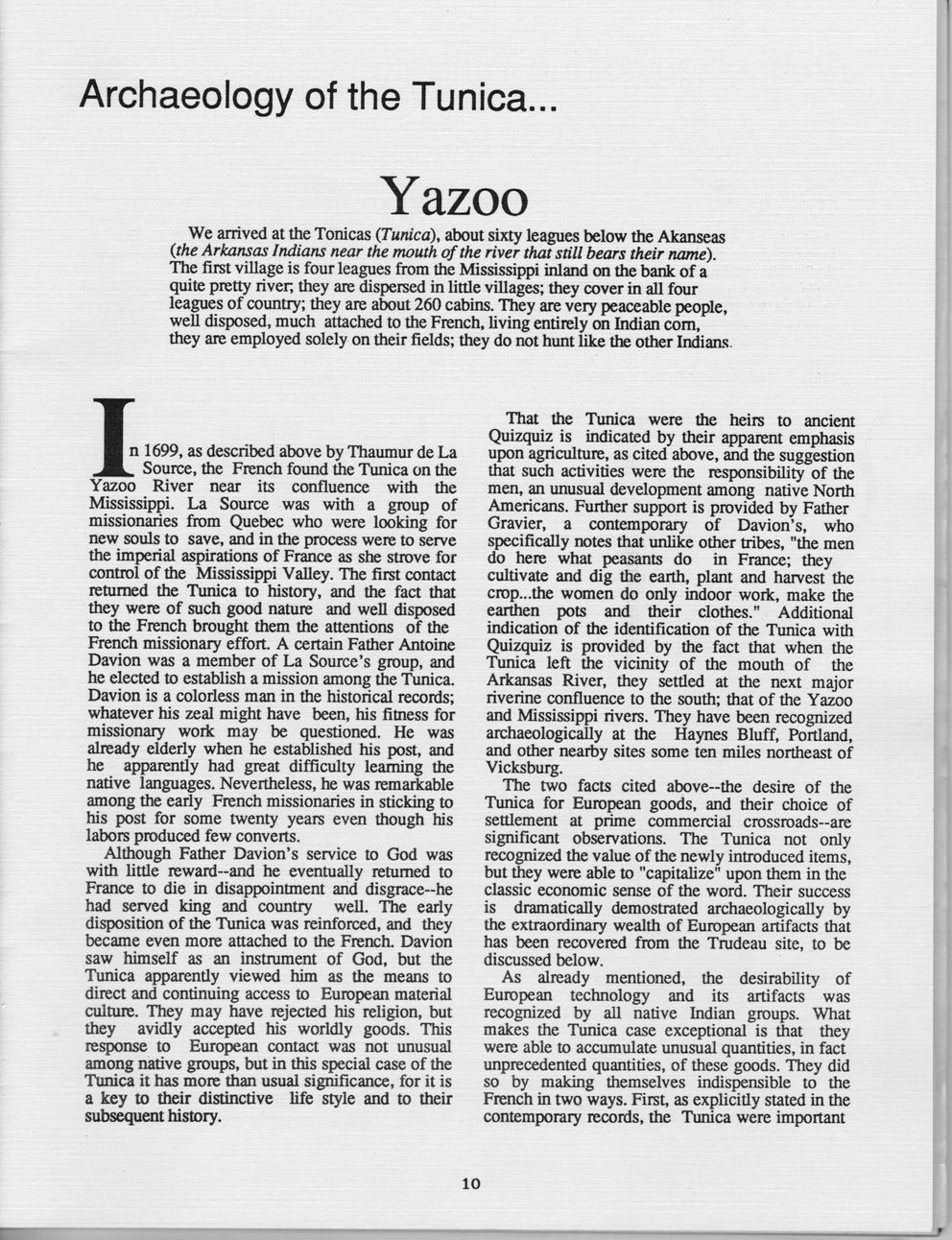This text was obtained via automated optical character recognition.
It has not been edited and may therefore contain several errors.
Archaeology of the Tunica... Yazoo We arrived at the Tonicas (Tunica), about sixty leagues below the Akanseas (the Arkansas Indians near the mouth of the river that still bears their name). The first village is four leagues from the Mississippi inland on the bank of a quite pretty river, they are dispersed in little villages; they cover in all four leagues of country; they are about 260 cabins. They are very peaceable people, well disposed, much attached to the French, living entirely on Indian com, they are employed solely on their fields; they do not hunt like the other Indians. In 1699, as described above by Thaumur de La . Source, the French found the Tunica on the Yazoo River near its confluence with the Mississippi. La Source was with a group of missionaries from Quebec who were looking for new souls to save, and in the process were to serve the imperial aspirations of France as she strove for control of the Mississippi Valley. The first contact returned the Tunica to history, and the fact that they were of such good nature and well disposed to the French brought them the attentions of the French missionary effort. A certain Father Antoine Davion was a member of La Source’s group, and he elected to establish a mission among the Tunica. Davion is a colorless man in the historical records; whatever his zeal might have been, his fitness for missionary work may be questioned. He was already elderly when he established his post, and he apparently had great difficulty learning the native languages. Nevertheless, he was remarkable among the early French missionaries in sticking to his post for some twenty years even though his labors produced few converts. Although Father Davion’s service to God was with little reward-and he eventually returned to France to die in disappointment and disgrace-he had served king and country well. The early disposition of the Tunica was reinforced, and they became even more attached to the French. Davion saw himself as an instrument of God, but the Tunica apparently viewed him as the means to direct and continuing access to European material culture. They may have rejected his religion, but they avidly accepted his worldly goods. This response to European contact was not unusual among native groups, but in this special case of the Tunica it has more than usual significance, for it is a key to their distinctive life style and to their subsequent history. That the Tunica were the heirs to ancient Quizquiz is indicated by their apparent emphasis upon agriculture, as cited above, and the suggestion that such activities were the responsibility of the men, an unusual development among native North Americans. Further support is provided by Father Gravier, a contemporary of Davion’s, who specifically notes that unlike other tribes, "the men do here what peasants do in France; they cultivate and dig the earth, plant and harvest the crop...the women do only indoor work, make the earthen pots and their clothes." Additional indication of the identification of the Tunica with Quizquiz is provided by the fact that when the Tunica left the vicinity of the mouth of the Arkansas River, they settled at the next major riverine confluence to the south; that of the Yazoo and Mississippi rivers. They have been recognized archaeologically at the Haynes Bluff, Portland, and other nearby sites some ten miles northeast of Vicksburg. The two facts cited above-the desire of the Tunica for European goods, and their choice of settlement at prime commercial crossroads-are significant observations. The Tunica not only recognized the value of the newly introduced items, but they were able to "capitalize" upon them in the classic economic sense of the word. Their success is dramatically demostrated archaeologically by the extraordinary wealth of European artifacts that has been recovered from the Trudeau site, to be discussed below. As already mentioned, the desirability of European technology and its artifacts was recognized by all native Indian groups. What makes the Tunica case exceptional is that they were able to accumulate unusual quantities, in fact unprecedented quantities, of these goods. They did so by making themselves indispensible to the French in two ways. First, as explicitly stated in the contemporary records, the Tunica were important 10 j

Native Americans The-Tunica-Biloxi-Tribe-its-Culture-and-People-(17)